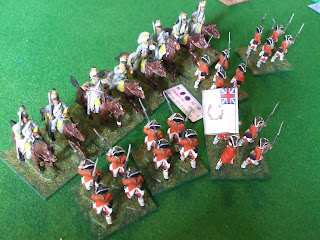The scenario revolved around a Cossack raid into the southern Muscovite provinces. Local defence forces were gathered and marched to the area. These were all second rate units similar to militia. Messages had been sent to the Provincial capitol requesting support from the main army, but for the moment, the locals were on their own. The Muscovite force consisted of
2 units of Noble Levy
2 units of urban streltsy
2 units of border muskets
1 unit of dismounted border dragoons.
2 pieces of artillery were available, a large gun in a redoubt by an old watchtower and a medium gun with the infantry. All the infantry were shielded within gulay gorod and chevaux de frise, erected within site of the Cossack camp. The Muscovite orders are to observe the Cossacks and try and contain them within the immediate area until the main army arrives. All the streltsy and border musket units are 'small' as rated by Pike and Shotte; the dragoons are standard. The noble Levy units are large.
The Cossack force has
2 units of horse
2 units of registered moloisty (Muskets only)
3 units of moloisty (spears and muskets)
1 unit of 'adventurers'
3 light guns.
Two of the moloisty regiments are large, the third is standard; the registered moloisty are standard and the 'adventurers' are small. The cavalry are both standard.
The Cossack commander has orders to carry out a deep reconnaissance and , seeing that he outnumbers the Muscovites in infantry and assuming his men are of better quality has decided to move out of his wagon laager and attack the units behind the chevaux de frise.
The general table layout
A couple of close-ups
 |
| The Cossack infantry prepare to advance |
 |
| The Muscovite border troops await the attack |
 |
| Battle is joined |
 |
| The Cossack cavalry commander flees with the remains of his force |
The moloisty suffered further casualties from the fire of the border dragoons and the artillery and broke to join in the rout.
On the Cossack right, the infantry had been charged by the second Noble Levy unit. Their defensive fire was weak, but they managed to hold the initial impetus of the cavalry and eventually drive them off. The relief was only temporary, as the other Noble Levy unit, having recovered from the brief melee with the Cossack cavalry, now charged them. Already weakened by their first melee, the infantry proved unable to prevail a second time and broke, running for the safety of the wagons.
 |
| Success before defeat |
The scenario did not work out as planned, with little actual combat at the chevaux de frise. A combination of extreme dice results in the initial cavalry melee, taken with a miscalculation regarding the size of the units ( the large Muscovite Noble Levy units were just too powerful) led to the Cossacks having little chance to advance.
After lunch Steve and I set up a different scenario with no cavalry; limiting ourselves to a straight infantry attack on the chevaux de frise. This proved a more balanced affair with several melees across the obstacles. In the end the better quality and numbers of the Cossacks prevailed.
 |
| Muscovite defenders |
 |
| Cossack attackers |
 |
| The streltsy driven back |
1 The chevaux de frise is an obstacle, but does not provide cover from missile fire
2 Units attacking across the chevaux de frise take a disruption test before melee. Roll a d6
Raw disordered on 4-6
Trained on 5-6
Elite on 6
(units with pike/spear add 1 to their score)
If a unit is already disordered before it takes the test and fails, it takes a casualty
3 A spear/pike unit holding a chevaux de frise strikes first in a melee with a non spear/pike armed unit; using half usual number of melee dice (rounded down) to calculate hits. These are resolved before normal melee procedure is followed.
4 An undefended chevaux de frise can be destroyed by a unit standing by it for one turn and carrying out no other action (including firing and rallying)































